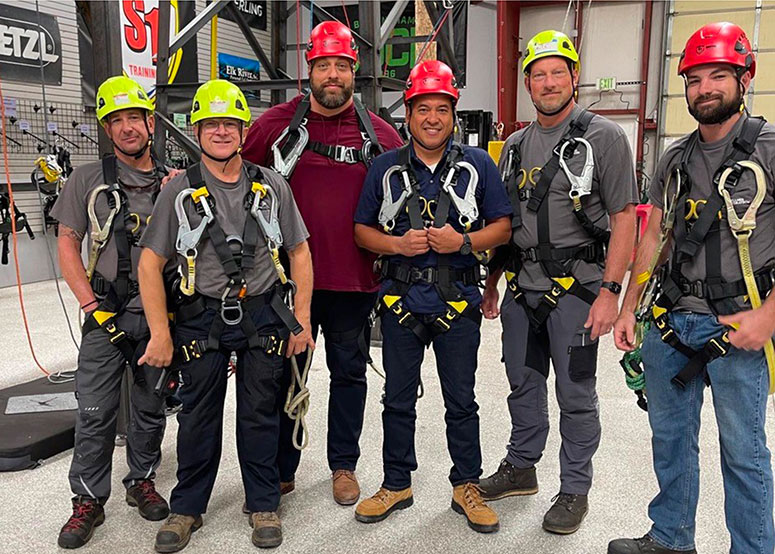Braking Reaches New Heights

BY: JOEL COX / GLOBAL SALES DIRECTOR – WIND / DELLNER BUBENZER GROUP
FEATURED IN WIND ENERGY NETWORK MAGAZINE
Component manufacturers that need to work at height on and around wind turbines, must keep their safety and rescue training up to date, as Joel Cox, Global Sales Director – Wind, at Dellner Bubenzer Group, reminds us...
There’s a temptation to think that component and ancillary equipment manufacturers are part of a supply chain that works on the periphery of the wind energy market, but equipment like heavy-duty brakes are at the industry’s heart. Therefore, it is of paramount importance that the people behind these products keep up their training and commit to continuing professional development (CPD) just as much as a service or product provider that works in wind or renewables only.
Wind Energy Sector
As we’ve said before, rotor, yaw, and pitch brakes, for example, are used in various wind energy applications. Rotor brakes are typically caliper style (active or passive) and Dellner offers rotor lock style pins (hydraulic, manual) for safety locking and maintenance purposes. Yaw brakes (active or passive) and sliding bearings along with special brakes are installed for pitch movement on the blades. All this means that we frequently have a requirement to send people up to work at height. And keeping those professionals trained is a priority.
In a recent example, we booked several personnel onto Safety One Training’s (of Littleton, Colorado, US) wind turbine climbing and rescue certification course. The programme is designed for technicians that are required to access and work on wind turbine structures, so it was perfect for our windfarm site sales managers and travelling engineers, to whom this is all in a day’s work.
Industry Growth
Much as we adhere to the most stringent of regulations, this course filled certain gaps in our knowledge when it came to some elements of equipment selection and inspection; use of tools; risk assessment; and especially emergency procedures. The wind energy industry is growing significantly and many suppliers are scrambling to learn more about climbing techniques and potential rescue situations. As Safety One says, turbine technicians can face many unique challenges when performing a rescue, including confined spaces, electrical hazards, varying platforms and ladder systems, even fires.
Here, we don’t look at learning and CPD as going back to school. We must keep energising and challenging our teams with new learning. It is vital for growth and team building to constantly remind everyone of their value to the business and that striving to be a pioneer in a market sector takes constant evolution. Never is training done or education finished. There’s always something else that can be added, even to the most experienced person’s armoury. Consider that new technologies and practices are being developed all the time.
Specialised Markets
This mindset is particularly important if, like us, you’re required to go to work in specialised end-user markets every day. Risks and action plans are sometimes the same but in industries like renewable energy, it often feels like plying your trade on an island and you’re heavily reliant on the people, processes and equipment in the immediate vicinity.
This isn’t work where you can shout across the street to a neighbour for help. This is only enhanced by the fact that, like cranes, these markets are being asked to go higher, faster and further than ever before. The risk as an ancillary equipment manufacturer or service provider goes up—literally—all the time.
Variations
Of course, it’s important to select the right training providers, and the appropriate level of learning for your team. Certain courseware will be too advanced for some and too entry level for others. The first thing to identify is an area where some additional knowledge might be required. If an individual or group of workers has been sent into a new marketplace, or a product is being introduced to an environment unfamiliar to the installation, inspection, maintenance, or service teams, this is a good place to start.
Not that wind energy was new to our workforce, but we set out to find courseware that specifically addressed accident and emergency situations, for added peace of mind. We were looking to build on an existing depth of working at height and fall arrest/protection knowledge.
Safety One
Safety One was clear from the outset that we would perform equipment selection and inspection; understand and use fall protection systems and rescue procedures; and prepare, evaluate and update planned rescue procedures. Based on that, we could select exactly who to send and what they’d come back to work with under their belts.
It’s clear why all teams, and the individuals within them, must be challenged and energised by new learning. As we’ve explored, no company becomes a market leader, or stays there, based only on what they learnt yesterday. Long-term success at the top of an industry requires supporting learning today and tomorrow. It might be a wind turbine climbing and rescue certification course or something completely different, but the next training programme your workers are exposed to will elevate standards within the business that little bit more. And in wind energy, that little bit more can be the difference between people going home to their families that evening or not.
